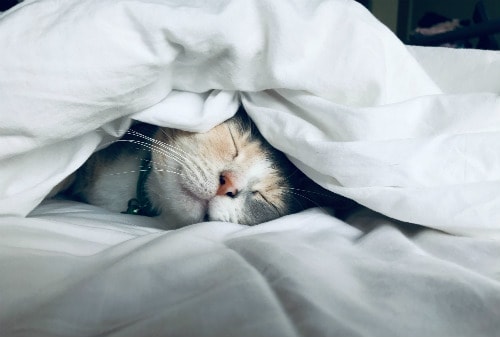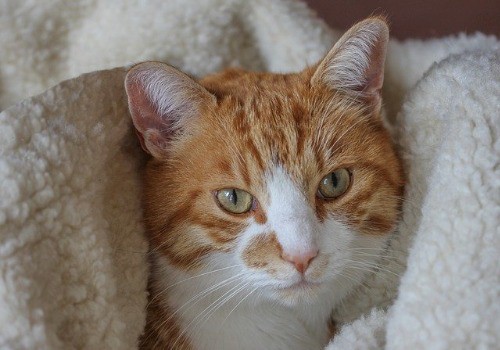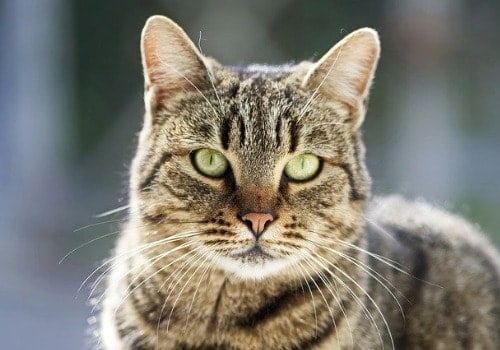It’s no secret that cats are creatures of comfort. They sleep up to 16 hours per day, they are constantly grooming themselves; it’s safe to say that cats are no strangers to self-care.
So, it begs the question, what is the ideal temperature for cats? This question entails a variety of factors, and the answer differs slightly among breeds. Let’s break it down.
The Ideal Temperature for Cats
Cats are warm and snugly critters with resting body temperatures above that of humans. A cat’s body temperature should be between 100.5 and 102.5 degrees Fahrenheit, while the cat is resting. Humans have a resting body temperature of 98 degrees Fahrenheit for comparison.
Since a cat’s body temperature is only slightly higher than a human’s, it follows that, if you’re comfortable with your home’s temperature, your cat likely is as well. Ideally, aim for a temperature of 65 to 75 degrees Fahrenheit, with 70 degrees Fahrenheit being the goal. Cats are at low risk of hypothermia, so a cooler home is acceptable, provided the cat has warm bedding to snuggle up in and shelter from the elements.
[amazon bestseller=”Cats bed”]
In the summertime, however, you need to be particularly cautious about maintaining your home’s temperature. Like dogs, cats are at high risk for heat stroke, so it’s important to run the AC in your home throughout the summer. For those without AC, be sure your home is well-ventilated, and your cat has plenty of access to fresh water and shade throughout the day.
Always be aware of your cat’s behavior, as there are some easy signs to look for to identify if your cat is too hot or too cold.
Factors for a Cat’s Adaptability to Temperature
Breed
Cat breeds that maintain thicker coats feel uncomfortable when temperatures are high. You’ll want to pay attention to them during the summer, especially if you live in a tropical environment. Remember, if it’s warm for you, it’s definitely warm for them.
Age
Younger cats need more heat than adult cats do.
Kittens don’t retain body heat as well as older cats. I like to keep a few blankets where my cats sleep so they can keep warm. It also adds to my peace of mind as I usually know where they are.
Size
As a general rule, the bigger the cat, the better he is at retaining heat. So overweight cats do better in cooler climates than skinnier ones.
Health
As is the case with humans, sick cats require warmer environments for comfort. If your cat isn’t doing well, consider raising the heat.
Signs Your Cat Is Too Hot
If your cat is feeling hot, they’ll exhibit the following signs:
- Check their gums. If their gums are red, it’s a sign they are overheating.
- Take note of panting. Unlike dogs, who regularly pant to cool down, panting in cats is much more worrisome. If you notice your cat panting, they are likely dangerously overheated and struggling to cool down.
- Notice your cat’s behavior. If your cat is slower or sluggish than usual, your little friend could be too hot.
- Observe your cat’s gait. If your cat seems more unstable than usual and is stumbling or wobbling as they walk, this indicates the cat could be overheating.
- If your cat is vomiting or has diarrhea in conjunction with any of the above symptoms, seek veterinary attention immediately. By this point, the cat isn’t just overheated but likely suffering from heatstroke.
[amazon bestseller=”cat automatic feeder for wet food”]
Signs Your Cat Is Too Cold

If your cat is feeling cold, they’ll exhibit the following signs:
- Feel their ears and tail. If the ears or tail feel cool, your cat has difficulty maintaining its body temperature.
- Notice if your cat is burrowing under blankets or cushions. If you see that your cat is regularly hiding out in warmer places, such as near the furnace or buried in a pile of blankets, it likely means the temperature of your home is too cold.
- Notice the position your cat is in. When a cat feels cold, it compresses its body by pulling its paws underneath its body and curling up tightly. By assuming this position, the cat is better able to conserve its energy and keep warm.
- Notice where in your home your cat takes its naps. Does your cat seek out sunny spots near windows? This likely means the cat is feeling cold and is, therefore, seeking out the warmest spots in your home.
Factors That Influence the Temperature Preferences of Your Cat
The temperature that one cat prefers will differ from another. This is due to a few factors but primarily your cat’s coat. Hairless cats, such as the Sphynx cat, will require a higher temperature to keep warm, whereas cats with thick, fluffy coats, like the Maine Coon cat, can maintain their body temperature in cooler weather.
Short-haired cats are the easiest to appease, and they can maintain their body temperatures more easily in both warm and cool weather. Take note of your cat’s coat, and be sure to adjust the temperature in your home accordingly to ensure their comfort in the cold, snowy winters, as well as the heat of summer.
The breed of your cat is another consideration. Certain breeds, such as Persian cats, are more susceptible to heat stroke. Cats with flat faces aren’t able to pant as efficiently, which means they have more difficulty cooling themselves down.
The age of your cat can also influence their susceptibility to heatstroke. Cats that are very young or very old will have a harder time regulating their body temperatures. They also have weaker immune systems at this age, so if they do get heatstroke, the risk of death is much higher.
[amazon bestseller=”air conditioner”]
Is It Better for Cats to Be Too Warm or Too Cold?

Obviously, the goal is to ensure your cat is at a comfortable temperature throughout the year. However, many wonder whether cats are more at risk in winter or summer. Generally speaking, it is easier for cats to warm up than it is for them to cool off.
This means that it’s more critical to maintain the temperature of your home in the summertime than it is in the wintertime. In the wintertime, if your cat is feeling cold, they have more opportunities to warm themselves up. This is assuming your cat has indoor access all winter long.
While indoors, a cat can nuzzle up by a furnace, nap in a sunny window-sill, curl up under a blanket, or snuggle with you to keep warm. In the summer, however, maintaining body temperature becomes more tricky. Unlike humans, an overheating cat cannot simply take off its coat to cool down.
Additionally, overheating can pose more serious health risks than cold weather. Cats are much more vulnerable to heatstroke than they are to hypothermia. Unlike humans, who have sweat glands to help regulate body temperature and prevent overheating, cats have limited options when it comes to cooling down.
Signs of Heat Stroke in Cats
Heat stroke is a very serious condition that progresses quickly. If left untreated, it can result in brain damage, organ failure, and is oftentimes fatal. Here are some of the top signs to look for:
- Rapid breathing
- Panting
- Slow body movements
- Delirium
- Stumbling and muscle weakness
- Excessive drooling
- Red gums
- A rectal temperature of 105 degrees Fahrenheit or above
- Tremors
- Seizures
- Vomiting
- Diarrhea
How to Minimize the Risk of Heat Stroke in Cats

While the risk of heat stroke is scary to many pet parents, fortunately there are a variety of ways to reduce and even eliminate the risk.
- Leave the AC on in summer. If you don’t have AC, be sure to run fans in your home to improve air circulation.
- Provide your cat with shady areas in your home that they can escape to. If your house has a lot of windows, crack open the door to a closet and stick a cat bed in there. Your cat needs to be able to access shady areas in summer to ensure it can escape the heat of the sun when needed.
- Ensure your cat always has clean water. Dehydration increases the risk of heatstroke, so it’s vital to make sure your cat always remains hydrated.
- Limit playtime on hot days. Hide the catnip and refrain from exciting your cat. Exercise increases body temperature quickly, and on hot days, it isn’t worth the risk.
[amazon bestseller=”Automatic Cat Water Fountain”]
Signs of Hypothermia in Cats
Fortunately, hypothermia is a low risk for indoor cats. Outdoor cats are most impacted, particularly if they’re wet. Nonetheless, it’s a good idea to know the key symptoms to look for.
- Difficulty breathing
- Stomach feels cold to the touch
- Pupils are dilated
- Shivering
- Muscle stiffness
- Lethargy
- Difficulty walking
How to Minimize the Risk of Hypothermia in Cats

The primary way to minimize the risk of hypothermia is to keep your cat indoors, particularly during winter. It’s also important to keep your cat dry, as cold weather with wet fur is a recipe for hypothermia. Provided your cat has access to shelter, away from the elements, and they have warm bedding to snuggle up in, the risk of hypothermia is very low.
Many cat owners wonder the ideal temperature to keep their cat comfortable. While it varies a bit depending on age, breed, and coat, most cats will be happy and comfortable at the same temperature humans are. A general rule of thumb is, if you’re comfortable with the temperature, your cat is too.
Still, it’s important to take note of any changes in your cat’s behavior, so you can be aware of any discomfort they may be feeling. Heatstroke is a major risk for cats, and it’s often fatal. Be sure to watch your cat for signs of heatstroke, and if they are exhibiting the symptoms, take them to the vet immediately.
"In ancient times cats were worshipped as gods; they have not forgotten this."
-- Terry Pratchett






Very helpful article and well written.
Well presented information, easy to understand. Thank you 🙏